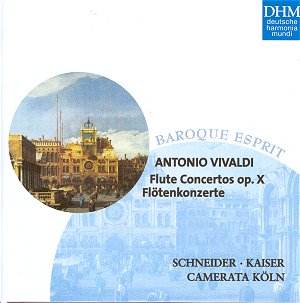This is one of those discs that plays total havoc with
any effort to categorise – especially if, like me, you use a computer-based
collection management programme to try to keep track of who is playing
whose what, with which and where. Most confusing of all to start with
is that half the works on this disc don’t appear in any of the main
Vivaldi catalogues as flute concertos, but as trio sonatas. Most of
the others appear as concerti grossi or violin concertos. Add
to this the fact that, although six of the seven share a common opus
number, they would appear to have been composed over a widely separated
number of years and also that Camerata Köln choose to use recorder
and flute alternately to ring the changes in the concerti. You now have
at least a flavour of my frustration.
It’s wonderful music, mind you. Exactly what I have
come to expect of Vivaldi – bright, bouncy, inventive and entirely satisfying
perfectly formed baroque works. these can be listened to on any level
from background music while cooking to deep meditation when the world
threatens to sweep one away. I do like Camerata Köln’s approach
to performance – untroubled and freely expressive, but immensely disciplined
from a rhythmic and dynamic standpoint. Their careful choice of instruments,
which is noted en passant in the liner notes, is certainly a
contributory factor to their fresh and vibrant sound, which the DHM
recording engineers have managed to capture and reproduce faithfully.
Some of this music I am familiar with in its original
form – or what I thought might have been the original form before I
read these notes. (Can you sense the return of my confusion?). I suppose
it comes from Vivaldi, like his Great Predecessor, having spent a productive
life writing vast quantities of music without paying too much attention
to what people were going to do with it in the dim and distant future.
Part of the liberal attitude towards instrumentation of recordings certainly
stems from the composer’s lack of detailed instructions, but part also
stems from the habits of the day. Trio sonatas were often played by
amateur and chamber groups with the instruments they happened to have
to hand, rather than those for which the piece was originally scored.
Add to this the fact that contemporary music publishers – ever with
an eye to the main chance – would publish ‘arrangements’ willy-nilly
if there was a market for them (and the flute was an increasingly popular
amateur instrument in the early 18th century). This is a
recipe designed to give my software indigestion.
Some of the music, though, is entirely new to me and
most welcome in this format. I have often thought the Red Priest ill
served by "Il Quattro Stagioni", in that the wider
audience often believes these to be the only major works in his oeuvre.
These concerti, however, are works of stature in their own right and
would serve as an excellent introduction for a Vivaldi neophyte. Beautiful
melodies, comfortable harmonies, stunning counterpoint and beautifully-phrased
by Camerata Köln – a worthy addition to any baroque lover’s shelf.
Now – if I can sort out why a disc entitled "Flute Concertos, Opus
10" finishes with a concerto for violin and oboe that has no opus
number at all, I’ll be able to file this one away and get on with the
next review!
Tim Mahon
